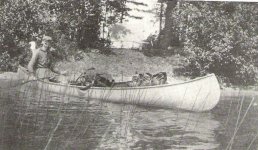Years ago I read about paddling tandems from the bow seat facing the stern. The benefits of increased stability and better trim where enough for me to adhere to this technique 100% of the time and I thought it was the only way to go. When I would see someone solo paddling a tandem from the stern with their bow way out of the water I assumed that they were either inexperienced or uninformed. This changed for me earlier this summer when for whatever the reason I don't remember I started paddling from the stern seat and realized the benefits of it. Firstly the more narrow seat position makes for more efficient and comfortable paddling. The second thing which is counter intuitive is that the boat turns on a dime because it is pivoting at the stern with little resistance from the water on the hull. This was with an empty boat, with a load you will loose the benefit of pivoting at the stern for easier turning but you will get the benefit of better trim and stability and still enjoy the ease of paddling.
I would like to add that the boat makes a difference. My 18' guide is pretty stable from the stern seat even having some secondary stability, same with my winona spirit II. The 18 footer is so stable I can paddle it while sitting on the deck. My 16' Yankee is also pretty good. My 16' OT guide which is a tippy boat to begin with is very doable but not too forgiving. Although the one time I had to use a brace to prevent a swim in it I was in the bow facing the stern, so there is no gauranty either way.
I would like to emphasize that it is safer to paddle from the bow seat, especially for the inexperienced who may not be confident and proficient with braces. It would also be easy to flip if the bow rose up on a submerged or at the surface obstacle like a stump. It works equally well if you are a hit and switch guy or using correction strokes. I was surprised at how easy it was to keep the bow going directly into a stiff wind, but once you get a few degrees off wind it will spin you around. I also found that I prefered using a longer paddle, especially in a breeze.
So what I once thought was the rule,(sitting in bow seat) is now the exception for me, and the guy paddling in our logo from the stern seat has it right.
I would like to add that the boat makes a difference. My 18' guide is pretty stable from the stern seat even having some secondary stability, same with my winona spirit II. The 18 footer is so stable I can paddle it while sitting on the deck. My 16' Yankee is also pretty good. My 16' OT guide which is a tippy boat to begin with is very doable but not too forgiving. Although the one time I had to use a brace to prevent a swim in it I was in the bow facing the stern, so there is no gauranty either way.
I would like to emphasize that it is safer to paddle from the bow seat, especially for the inexperienced who may not be confident and proficient with braces. It would also be easy to flip if the bow rose up on a submerged or at the surface obstacle like a stump. It works equally well if you are a hit and switch guy or using correction strokes. I was surprised at how easy it was to keep the bow going directly into a stiff wind, but once you get a few degrees off wind it will spin you around. I also found that I prefered using a longer paddle, especially in a breeze.
So what I once thought was the rule,(sitting in bow seat) is now the exception for me, and the guy paddling in our logo from the stern seat has it right.

